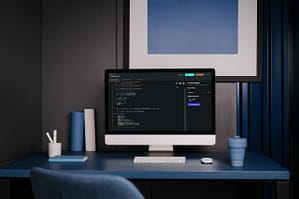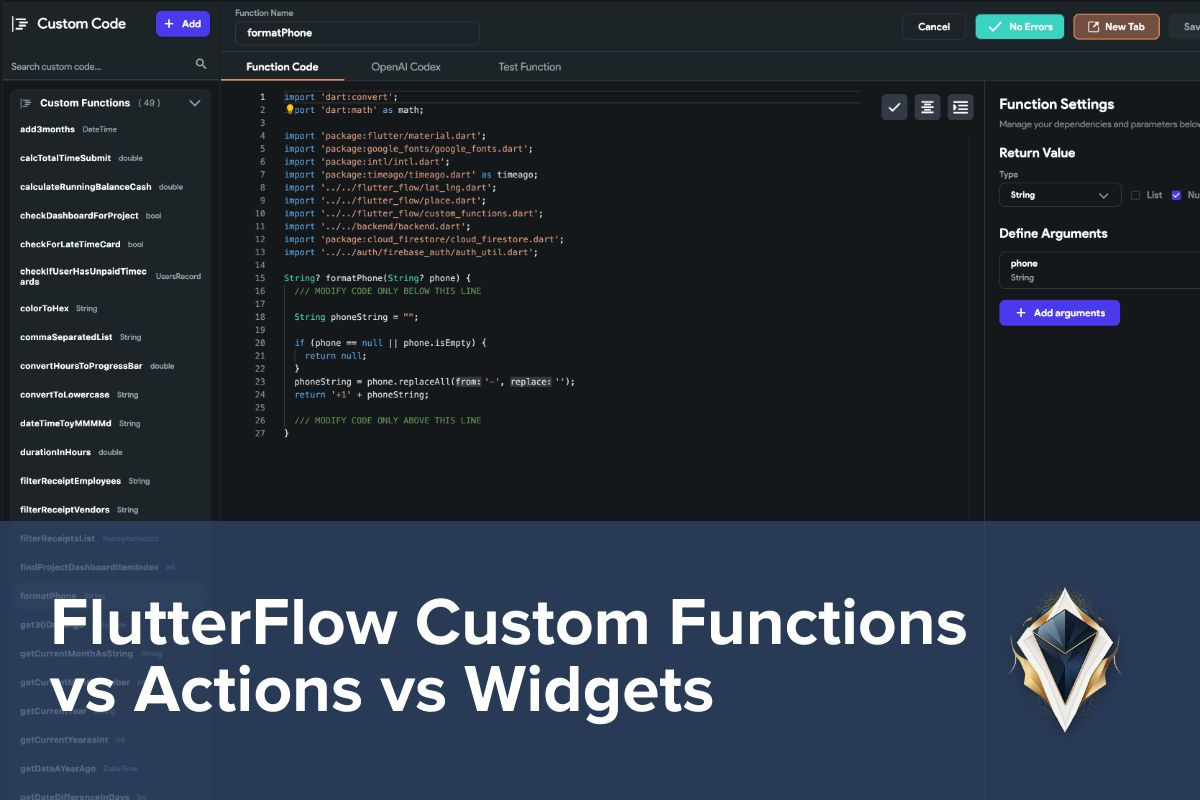 Since FlutterFlow is a relatively new platform, one question I often come across when working with clients and mentoring aspiring developers is, “What is the difference between custom functions, custom actions, and custom widgets in FlutterFlow?” or simply “Custom Functions vs Actions vs Widgets.”
Since FlutterFlow is a relatively new platform, one question I often come across when working with clients and mentoring aspiring developers is, “What is the difference between custom functions, custom actions, and custom widgets in FlutterFlow?” or simply “Custom Functions vs Actions vs Widgets.”
Hello, I’m Mario Flawless, CEO of Flawless App Design, an app development company that specializes in FlutterFlow app development. Today, I’d like to provide you with a comprehensive comparison to help clear up any confusion.
Understanding the distinctions between these three tools is essential for creating seamless and efficient apps. In this blog post, we will delve into the definitions, use cases, benefits, and limitations of custom functions, actions, and widgets.
By the end of this post, you’ll have a solid understanding of when to use each tool and how to make the most of them in your FlutterFlow projects. Let’s dive in!
Custom Functions

Custom functions are user-defined pieces of reusable code that perform specific tasks within a FlutterFlow app. These functions allow developers to create tailored solutions for unique challenges, streamline processes, and minimize code repetition.
When to use custom functions
Custom functions are ideal when you need to perform a particular operation multiple times throughout your app. They’re also useful for encapsulating complex logic, making it easier to maintain and update the code as needed.
Examples and use cases
- Calculating discounts: You could create a custom function that takes the original price and discount percentage as inputs and returns the discounted price. This function can be reused whenever you need to apply discounts in your app.
- Date formatting: If your app displays dates in a specific format, you can create a custom function to convert the input date into the desired format, ensuring consistency throughout the app.
- Converting data types: If you store data a certain way but you need it in a different format, you can use a custom function to convert the data. For example, aphone number is sometimes stored as integers OR text strings. You can simply convert an integer to a string or string to integer to match the data types (which is super helpful in CRUD operations).
Benefits and limitations
Benefits:
- Reusability: Custom functions can be used in multiple parts of your app, reducing code duplication and improving maintainability.
- Abstraction: Encapsulating complex logic in functions makes the code easier to understand and manage.
- Flexibility: With custom functions, you can create tailored solutions for unique challenges in your app development process.
Limitations:
- Learning curve: Writing custom functions requires a solid understanding of programming concepts and the specific syntax of the language used.
- Debugging: Debugging custom functions can be challenging, as errors might be harder to trace back to their source.
- Overcomplication: Overusing custom functions may lead to unnecessary complexity in your app, making it more challenging to maintain and modify.
Custom Actions

Custom actions are predefined, self-contained units of functionality that can be easily integrated into your app’s workflow. They enable developers to automate specific tasks or trigger events without writing complex code. Custom actions often interact with external services, APIs, or databases to perform their tasks.
When to use custom actions
Use custom actions when you want to simplify common tasks or automate processes that involve external services or data sources. They’re particularly helpful when you need to implement functionality that’s not available as a built-in FlutterFlow component.
Examples and use cases
- OpenAI (ChatGPT functionality): : A custom action that parses the response data from an API call to OpenAI (or better known as ChatGPT), which can be helpful for calculating token usage of the API.
- Social media integration: Custom actions can be designed to post updates or fetch data from social media platforms like Twitter, Facebook, or Instagram.
- Payment processing: Custom actions can help integrate payment gateways like Stripe or PayPal into your app, enabling secure and efficient transactions.
- Bulk CRUD operations: You can perform bulk operations to the database with custom actions, which speeds up and iterates processes to optimize the actions for speed.
Benefits and limitations
Benefits:
- Simplification: Custom actions allow developers to implement complex functionality with minimal coding effort.
- Modularity: Actions are self-contained, making it easy to reuse them across different parts of your app.
- Integration: Custom actions help connect your app to external services or APIs, expanding its capabilities.
Limitations:
- Limited control: Custom actions offer less control over the underlying code compared to custom functions, which might be an issue when fine-tuning the app’s behavior.
- Dependency: Custom actions often rely on external services or APIs, which may cause issues if these dependencies become unavailable or undergo changes.
- Documentation: Thorough documentation is necessary to ensure other developers understand the purpose and functionality of a custom action, especially when working in a team environment.
Custom Widgets
Custom widgets are user-created UI components that extend the functionality of the existing FlutterFlow widget library. They allow developers to build unique and reusable interface elements tailored to their app’s design and user experience requirements.
When to use custom widgets
Use custom widgets when the built-in FlutterFlow widget library doesn’t provide the desired UI component or when you need to create a specialized element that encapsulates specific design or functionality. Custom widgets are particularly useful for maintaining a consistent look and feel across your app.
Examples and use cases
- Custom events calendar: JaeHo Song created a custom events calendar that displays the number of events next to the date on a nice calendar.
- Image cropper: Gary Evans created a custom image cropper that allows you to simply crop images within FlutterFlow without using an external API or tool.
- Phone contacts: Charles Fairbairn created a custom contacts widget to display the user’s phone contacts within the FlutterFlow app.
Benefits and limitations
Benefits:
- Consistency: Custom widgets enable a cohesive design language throughout your app, enhancing the overall user experience.
- Reusability: Once created, custom widgets can be easily reused across different screens or even in other projects.
- Customization: Custom widgets give developers complete control over appearance and functionality, allowing them to create unique solutions tailored to their app’s needs.
Limitations:
- Complexity: Designing and implementing custom widgets can be more complex than using built-in widgets, requiring a deeper understanding of Flutter and its widget system.
- Maintenance: As your app evolves, custom widgets may require updates or modifications, which can be time-consuming.
- Performance: Poorly designed custom widgets might negatively impact your app’s performance, especially if they’re not optimized for efficient rendering and resource usage.
Comparing Custom Functions, Actions, and Widgets
Key differences
Custom Functions: Reusable pieces of code that perform specific tasks, ideal for encapsulating complex logic and minimizing code repetition.
Custom Actions: Predefined, self-contained units of functionality that automate tasks or interact with external services, APIs, or databases, simplifying common processes.
Custom Widgets: User-created UI components that extend the existing FlutterFlow widget library, allowing developers to create unique and reusable interface elements tailored to their app’s design and user experience requirements.
Selecting the right tool for the job
Choose custom functions when you need to perform a particular operation multiple times, encapsulate complex logic, or create tailored solutions for unique challenges.
Opt for custom actions when you want to simplify common tasks, automate processes involving external services, or implement functionality not available as a built-in FlutterFlow component.
Utilize custom widgets when the built-in library doesn’t provide the desired UI component, or when you need to create specialized elements that encapsulate specific design or functionality for a consistent look and feel across your app.
By understanding the differences between custom functions vs actions vs widgets, you can make better decisions for your project.
Integrating custom functions vs actions vs widgets in a project
For custom functions, organize them in a dedicated module or file to keep your codebase clean and maintainable.
When implementing custom actions, ensure that proper documentation is provided, and handle any dependencies or API changes to maintain the stability of your app.
While using custom widgets, make sure they’re optimized for efficient rendering and resource usage. Store them in a shared library, making it easy to reuse and update them across different screens or projects. This will help you effectively utilize custom functions vs actions vs widgets in your app development.
Best Practices and Tips
Custom Function best practices
- Keep functions focused: Each custom function should have a single, well-defined purpose to ensure maintainability and readability.
- Use meaningful names: Choose descriptive function names that clearly convey their purpose, making the code more understandable.
- Keep functions small: Limit the size of your functions to a manageable length, making it easier to comprehend and debug.
- Validate input parameters: Ensure that the input parameters passed to your custom functions are validated to prevent unexpected behavior or errors.
- Comment and document: Provide comments and documentation to help other developers understand the purpose and usage of your custom functions.
Custom Action best practices
- Be specific: Design your custom actions to perform specific tasks or interact with particular external services or APIs, keeping them focused and easy to understand.
- Handle errors gracefully: Implement proper error handling within your custom actions to ensure a smooth user experience even if external services or APIs fail.
- Document dependencies: Clearly document any external services, APIs, or databases your custom action relies upon, making it easier for other developers to understand and maintain.
- Ensure modularity: Make your custom actions modular and self-contained, allowing for easy reuse and integration across different parts of your app.
- Test thoroughly: Test your custom actions rigorously to ensure they work as expected and handle edge cases properly.
Custom Widget best practices
- Optimize performance: Design your custom widgets with performance in mind, ensuring efficient rendering and resource usage.
- Ensure reusability: Create custom widgets that can be easily reused across different screens or projects, making your development process more efficient.
- Follow design guidelines: Adhere to established design guidelines and principles to create visually appealing and user-friendly custom widgets.
- Document and comment: Provide clear documentation and comments to help other developers understand the purpose, functionality, and usage of your custom widgets.
- Test on multiple devices: Test your custom widgets on a variety of devices and screen resolutions to ensure they look and function well across different platforms.
FlutterFlow Custom Functions vs Actions vs Widgets Conclusion
In this blog post, we explored the differences between custom functions vs actions vs widgets in FlutterFlow, or the comparison between custom functions vs actions vs widgets.
Custom functions are reusable pieces of code for specific tasks, custom actions are predefined units of functionality that automate tasks or interact with external services, and custom widgets are user-created UI components that extend the existing widget library.
Choosing the right tool for your app development is crucial for creating efficient, maintainable, and user-friendly applications. Understanding the differences between custom functions, actions, and widgets can help you make informed decisions and build robust, scalable apps.
We encourage you to explore and experiment with custom functions vs actions vs widgets in your FlutterFlow projects. By mastering these tools, you can unleash the full potential of FlutterFlow, creating truly unique and powerful applications.
If you’re interested in learning more or need guidance with your app development journey, consider reaching out to our expert team at Flawless App Design for FlutterFlow mentoring or custom app development services. We’re here to help you turn your app ideas into reality!






How use a custom function inside a action code ou widget ?
That’s a great question. Can you explain what you’re trying to accomplish? The more detail you provide, the easier it will be for me to understand and provide you with a solution.